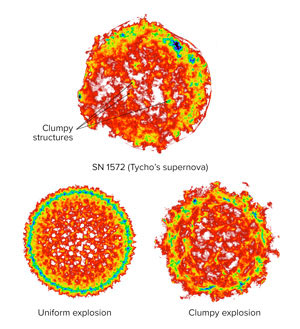| Oct 11, 2019 |
Clumpy structure in remnant probably formed in supernova explosion itself
|
|
(Nanowerk News) RIKEN astrophysicists have found strong evidence that the clumpy structure of the 450-year-old remnant of a supernova explosion originated from the explosion itself and not from processes that occurred after the explosion (The Astrophysical Journal, "Genus statistic applied to the X-ray remnant of SN 1572: clues to the clumpy ejecta structure of type Ia supernovae"). This goes some way towards unveiling the mystery that shrouds supernova explosions.
|
|
Danish nobleman Tycho Brahe was taking an evening stroll on 11 November 1572 when he spotted a new star that outshone all other stars. The star gradually faded, becoming too faint to see with the naked eye after about a year and a half. It had to wait until the 1960s for telescopes to become powerful enough to detect it again.
|
|
The ‘new star’ turned out to be a supernova explosion of an old star that had reached the end of its life. And what astronomers observe today are the remnants of that explosion.
|
 |
| The top image is an x-ray of the supernova remnant SN 1572 (also known as Tycho’s supernova). The bottom two images show a simulation of a uniform explosion (left) and a ‘clumpy’ explosion (right). The x-ray image of the supernova remnant clearly resembles the clumpy explosion more than the uniform one. (© AAS)
|
|
X-ray images of the remnant reveal that it has a distinctly clumpy appearance, and much speculation exists about the origin of this clumpiness. There are two main theories: one posits that the clumps were present in the explosion itself, whereas the other hypothesizes that they arose during the subsequent dispersion of gas.
|
|
Now, by performing a statistical analysis of x-ray images of the remnant, Toshiki Sato at the RIKEN High Energy Astrophysics Laboratory and his co-workers have found compelling evidence that the clumpiness arose from the explosion.
|
|
In their analysis, the researchers used a statistic known as the genus statistic, which expresses the topology of a geometric object. “The genus statistic allows us to count the number of isolated ‘holes’ and ‘clumps’ in a field,” explains Sato.
|
|
When the team applied the genus statistic to an x-ray image of the Tycho supernova remnant, the pattern they obtained resembled one they had observed in a ‘clumpy’ explosion model, but it was quite different from the pattern they had noted in a uniform explosion model.
|
|
The team was encouraged by the effectiveness of the genus statistic. “I didn’t imagine that the genus statistic would work as well as it did in this study,” says Sato. “The two models look very different from each other. This was very interesting for us since it indicates that the genus statistic is a powerful tool for discriminating differences in distributions.”
|
|
The team now intends to apply the genus statistic to new models for the evolution of supernova remnants. “We expect that the genus statistic will be a key to understanding the evolution from supernovae to the supernova remnants in the coming decades,” says Sato.
|

